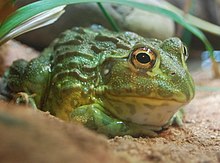
Amphibians are ectothermic, anamniotic, four-limbed vertebrate animals that constitute the class Amphibia. In its broadest sense, it is a paraphyletic group encompassing all tetrapods, excluding the amniotes. All extant (living) amphibians belong to the monophyletic subclass Lissamphibia, with three living orders: Anura (frogs), Urodela (salamanders), and Gymnophiona (caecilians). Evolved to be mostly semiaquatic, amphibians have adapted to inhabit a wide variety of habitats, with most species living in freshwater, wetland or terrestrial ecosystems. Their life cycle typically starts out as aquatic larvae with gills known as tadpoles, but some species have developed behavioural adaptations to bypass this.

A frog is any member of a diverse and largely carnivorous group of short-bodied, tailless amphibians composing the order Anura. The oldest fossil "proto-frog" Triadobatrachus is known from the Early Triassic of Madagascar, but molecular clock dating suggests their split from other amphibians may extend further back to the Permian, 265 million years ago. Frogs are widely distributed, ranging from the tropics to subarctic regions, but the greatest concentration of species diversity is in tropical rainforest. Frogs account for around 88% of extant amphibian species. They are also one of the five most diverse vertebrate orders. Warty frog species tend to be called toads, but the distinction between frogs and toads is informal, not from taxonomy or evolutionary history.

A tadpole is the larval stage in the biological life cycle of an amphibian. Most tadpoles are fully aquatic, though some species of amphibians have tadpoles that are terrestrial. Tadpoles have some fish-like features that may not be found in adult amphibians such as a lateral line, gills and swimming tails. As they undergo metamorphosis, they start to develop functional lungs for breathing air, and the diet of tadpoles changes drastically.
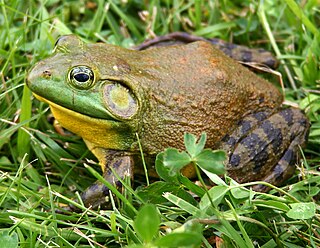
The American bullfrog, often simply known as the bullfrog in Canada and the United States, is a large true frog native to eastern North America. It typically inhabits large permanent water bodies such as swamps, ponds, and lakes. Bullfrogs can also be found in manmade habitats such as pools, koi ponds, canals, ditches and culverts. The bullfrog gets its name from the sound the male makes during the breeding season, which sounds similar to a bull bellowing. The bullfrog is large and is commonly eaten throughout its range, especially in the southern United States where they are plentiful.
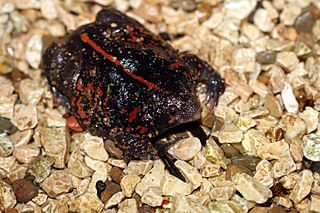
The Mexican burrowing toad is the single living representative of the family Rhinophrynidae. It is a unique species in its taxonomy and morphology, with special adaptations to assist them in digging burrows where they spend most of their time. These adaptations include a small pointed snout and face, keratinized structures and a lack of webbing on front limbs, and specialized tongue morphology to assist in feeding on ants and termites underground. The body is nearly equal in width and length. It is a dark brown to black color with a red-orange stripe on its back along with splotches of color on its body. The generic name Rhinophrynus means 'nose-toad', from rhino- (ῥῑνο-), the combining form of the Ancient Greek rhis and phrunē.

The banded bullfrog is a species of frog in the narrow-mouthed frog family Microhylidae. Native to Southeast Asia, it is also known as the Asian painted frog, digging frog, Malaysian bullfrog, common Asian frog, and painted balloon frog. In the pet trade, it is sometimes called the chubby frog. Adults measure 5.4 to 7.5 cm and have a dark brown back with stripes that vary from copper-brown to salmon pink.

Pyxicephalus is a genus of true frogs from Sub-Saharan Africa, commonly referred to as African bull frogs or bull frogs. They are very large to large frogs, with females significantly smaller than males. They may take decades to reach their full size potential and they are some of the longest-living frogs, possibly able to reach ages as high as 45 years.

The pig frog is a species of aquatic frog found in the Southeastern United States, from South Carolina to Texas. Some sources also refer to it as the lagoon frog or the southern bullfrog.

Hoplobatrachus crassus, also called Jerdon's bullfrog, Jerdon's bull frog, and South Indian bullfrog, is a species of frog found widely distributed on the plains of India, Bangladesh, Nepal, and Sri Lanka. Its range may extend to the adjacent Bhutan and Myanmar.
Cardioglossa melanogaster is a species of frog in the family Arthroleptidae. It is found in the mountains of western Cameroon and eastern Nigeria. Common name Amiet's long-fingered frog has been coined for it.
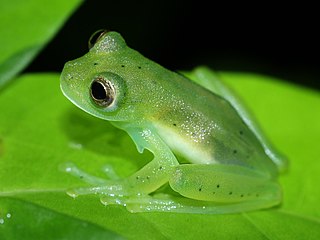
The Andes giant glass frog is a species of frog in the family Centrolenidae. It is found in the Cordillera Oriental of Colombia and the Mérida Andes and Serranía del Perijá of Venezuela.

The knife-footed frog is a species of burrowing frog in the family Hylidae. It is endemic to Australia, where it is found over a wide area in the north of the continent.
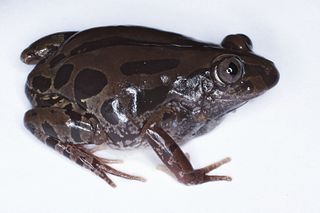
Kassina senegalensis, also known as the Senegal running frog, along with many other common names, is a species of frog native to much of Africa. It is a small and solidly-built species with large eyes. Most of the body is greyish-black, but there are brown bands and spots on certain parts. They can be found in many types of habitats, such as shrublands, grasslands, and wetlands, at elevations as high as 2,000 metres (1.2 mi). Their breeding occurs in water, where eggs are laid in various locations and fertilised one by one. They eat a variety of arthropods and secrete peptides from their skin to avoid becoming prey themselves. Their population is assumed to be very large and not in any immediate danger.
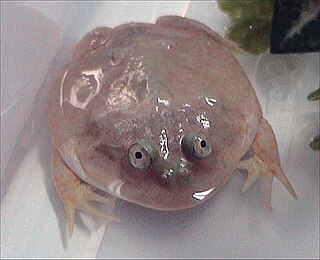
Lepidobatrachus laevis, widely known as Budgett's frog, is a species of frog in the family Ceratophryidae, discovered by John Samuel Budgett. It is often kept as a pet. It has acquired a number of popular nicknames, including hippo frog, Freddy Krueger frog, and escuerzo de agua.

The giant banjo frog, giant pobblebonk frog, giant bullfrog, or great bullfrog is a species of frog, endemic to Australia, in the family Limnodynastidae. Fry was the first to recognise the species of Giant Banjo Frog as a distinct subspecies of Banjo Frog, differing from the similar Southern or Eastern Banjo Frogs which occupied most of eastern Australia.

Breviceps adspersus, also known as common rain frog, bushveld rain frog, and many other vernacular names, is a species of frog in the family Brevicipitidae. It is found in Southern Africa, in Angola, Democratic Republic of the Congo, Namibia, Botswana, Zambia, Zimbabwe, South Africa, Eswatini, and Mozambique.

The edible bullfrog, also known as the pixie frog, lesser bullfrog or Peter's bullfrog, is a large-bodied African species of frog in the family Pyxicephalidae.

The Ranoidea are a superfamily of frogs in the order Anura. Members of this superfamily are characterised by having the pectoral girdle fused into a single complex unit, having no ribs, and using an axillary grip during amplexus. The larvae have a single spiracle on the left side and complex mouthparts, or in some species, undergo direct development. The taxonomy of these families has been under heavy debate for many years. In recent studies, molecular data has been used to better identify the phylogentic relationships of these frogs, rearranging and introducing new subfamilies to better distinguish between large groups of frogs.
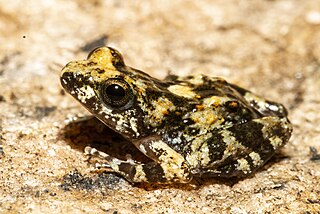
Nothophryne unilurio, also known as the Quirimbas mongrel frog, is a species of frog in the family Pyxicephalidae described in 2018. It is endemic to Taratibu Nills in northern Mozambique. The specific name unilurio is derived from Lúrio University, or Unilúrio, the name of a Mozambican university responsible for the research that culminated with the finding of the new species.

